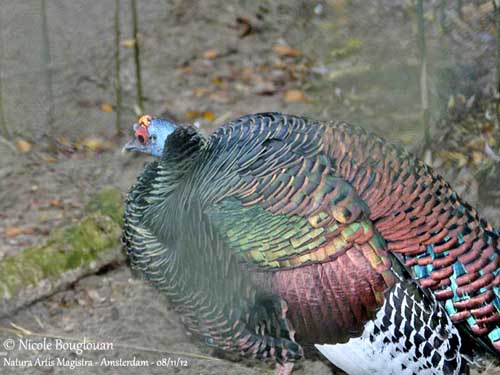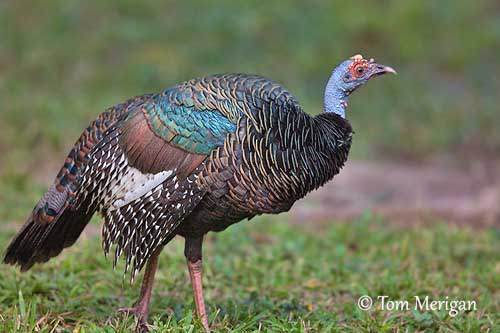
Fr: Dindon ocellé
All : Pfauentruthuhn
Esp : Guajolote Ocelado
Ital : Tacchino ocellato
Nd: Pauwkalkoen
Sd: Arguskalkon
Photographers:
Tom Merigan
Tom Merigan’s Photo Galleries
Nicole Bouglouan
PHOTOGRAPHIC RAMBLE
Text by Nicole Bouglouan
Sources:
HANDBOOK OF THE BIRDS OF THE WORLD Vol 2 by Josep del Hoyo-Andrew Elliot-Jordi Sargatal - Lynx Edicions - ISBN: 8487334156
Hennache, A. & Ottaviani, M. (2005). Monographie des faisans, volume 1. Edition W.P.A. France, Clères, France. ISBN: 2-9512467-1-4
Hennache, A. & Ottaviani, M. (2006). Monographie des faisans, volume 2. Edition W.P.A. France, Clères, France.ISBN: 2-9512467-2-2
Les auteurs renoncent à leurs droits d'auteurs pour que la vente de cet ouvrage, publié par la World Pheasant Association, soit destinée à soutenir des projets de conservation.
BirdLife International (BirdLife International)
Neotropical Birds – Cornell Lab of Ornithology
Wikipedia, the free encyclopaedia
Ocellated Turkey
Meleagris ocellata
Galliforme Order – Phasianidae Family
BIOMETRICS:
Length: 71-92 cm
Weight: M: 4000 g – F: 3000 g
DESCRIPTION:
The Ocellated Turkey is smaller but more colourful than the Wild Turkey (Meleagris gallopavo). It occurs in restricted range in Central America where it is vulnerable to habitat destruction and hunting pressure.
The adult male has iridescent plumage, a beautiful mix of glossy bronze and green. Tail-coverts and rectrices are bluish-grey, with distinctive blue-bronze eye-shaped spots (ocelli) on subterminal band and golden tips according to the lighting.
On the wings, most of secondary wing-coverts are rich iridescent copper. Primary and secondary flight feathers show black and white barring, with more white on secondaries.
Head and neck show bright blue bare skin with orange to red warty caruncles called nodules, usually more numerous on males. The male has fleshy bleu crown with conspicuous nodules.
These ornaments become brighter and more prominent during the breeding season. During this period, the male shows bare, bright red eyering.
The bill is blackish with pinkish-horn tip. The eyes are brown. Legs and feet are deep red. The male shows impressive spurs of up to 40 mm.

The female has similar plumage but duller. Her iridescent feathers are greener with less bronze. She is smaller and lacks spurs or has very short ones.
The juvenile has much duller plumage and shows pink, brown and cinnamon barring.
VOICE: SOUNDS BY XENO-CANTO
The Ocellated Turkey produces gobbles during the breeding season to attract females. This is a far-carrying sound which can be heard over two kilometres away “wump-wump-wump pum-pum-pum-peedle-glunk”
Calls are variable depending on the situation. The voice of this species is not currently well described.
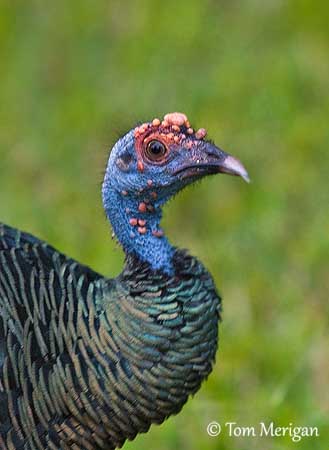
HABITAT:
The Ocellated Turkey frequents tropical deciduous and lowland evergreen forests, and a combination of dense forest and clearings or open grassy areas. It usually lives in the dense forest, but it reaches more open areas in autumn, in order to feed on agricultural crops.
RANGE:
The Ocellated Turkey has restricted range in Central America, in Yucatán Peninsula, in five states of Mexico, and in parts of Belize and Guatemala.
BEHAVIOUR:
The Ocellated Turkey feeds on the ground and is omnivorous, taking grass seeds and leaves, buds, flowers, corn, fruits and insects.
It scratches down the ground through the leaf litter and the soil, searching for food. During winter, it scratches for plant rhizomes.
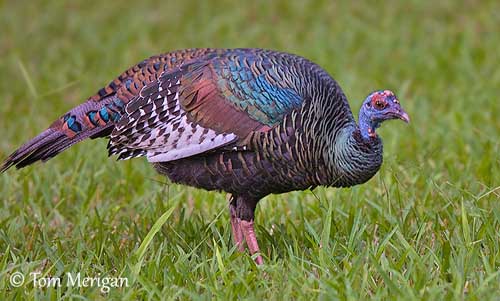
The Ocellated Turkey is diurnal. At night, it roosts in trees to escape predators. It is usually more active in the early morning and at dusk.
This species is mainly territorial, spending most of its time on the ground.
At the beginning of the breeding season, the male utters calls starting with low notes and then, increasing in pitch and volume, ending in high-pitched yelps. Such call is usually given around sunrise, and the female responds with series of clucks.
Courtship displays and breeding behaviour include vocal and visual signals. The gobble call attracts the females. The male drops the wings, and erects the fanned tail and most of dorsal feathers, in order to display the iridescent plumage pattern.
The blue head and neck are held tightly against the back while the male produces a low puffing sound. If the female is receptive, she squats and the copulation occurs.
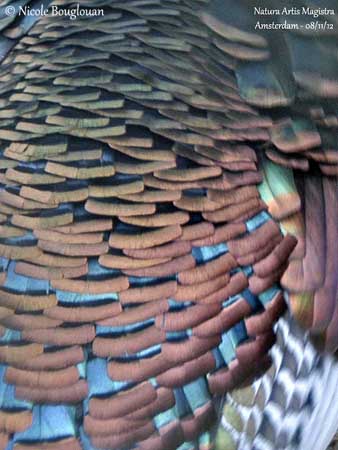
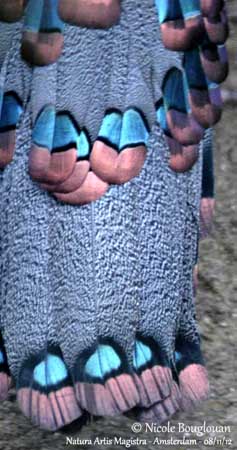
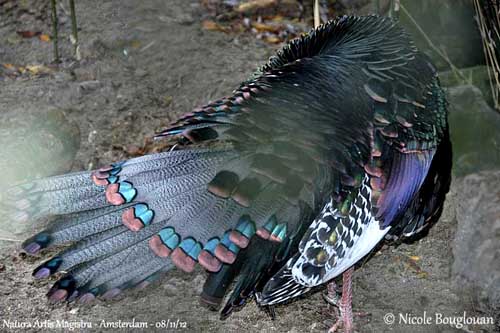
The Ocellated Turkey’s movements are poorly known, but it probably performs some short movements according to the food resources.
FLIGHT:
The Ocellated Turkey, as most Phasianidae species, is mainly terrestrial and prefers to escape predators by running rather than flying.
However, it is able to fly very well. The take-off is short and powerful, followed by long glide. The flight usually begins from a tree or other perch, helping the bird to glide as far as a kilometre. It also performs short bursts of active flight.
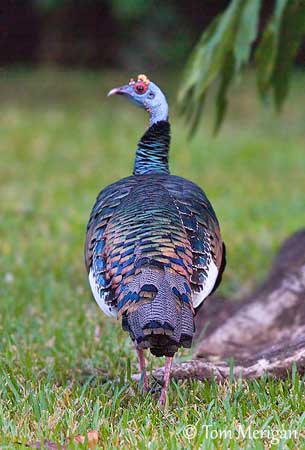
REPRODUCTION:
The breeding season starts in March-April.
The Ocellated Turkey’s nest is a shallow depression on the ground, a scrape made by the female. The male does not perform any nesting duties.
She lays 8-15 creamy to buff eggs with irregular darker markings. Incubation lasts 28 days. The young are precocial and feed on insects during the first days, before to become omnivorous at about six weeks old. Their first flying attempts begin at 2-3 weeks of age.
Female and young at nest are vulnerable to ground predators such as foxes, skunks, racoons, coyotes and bobcats, and birds of prey too.
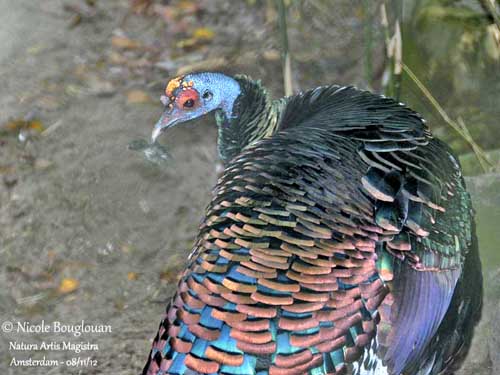
DIET:
The Ocellated Turkey is omnivorous, feeding on grass seeds and leaves, flowers, buds, rhizomes, fruits and insects. It feeds by walking on the ground.
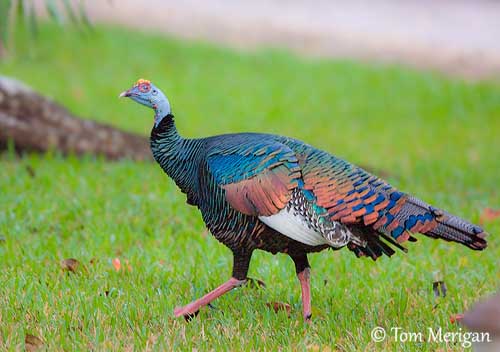
PROTECTION / THREATS / STATUS:
The Ocellated Turkey has small populations living in restricted range. This turkey is well protected in Tikal National Park in Guatemala, and there are some other protected areas in its range.
But heavy hunting, deforestation for agriculture expansion and fragmentation of the habitat make this species listed as Near Threatened.
